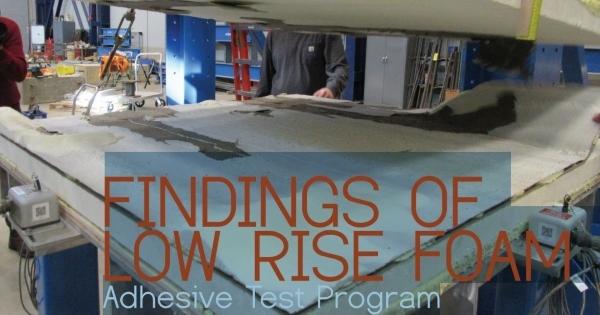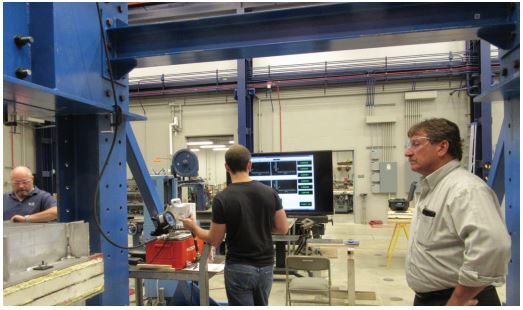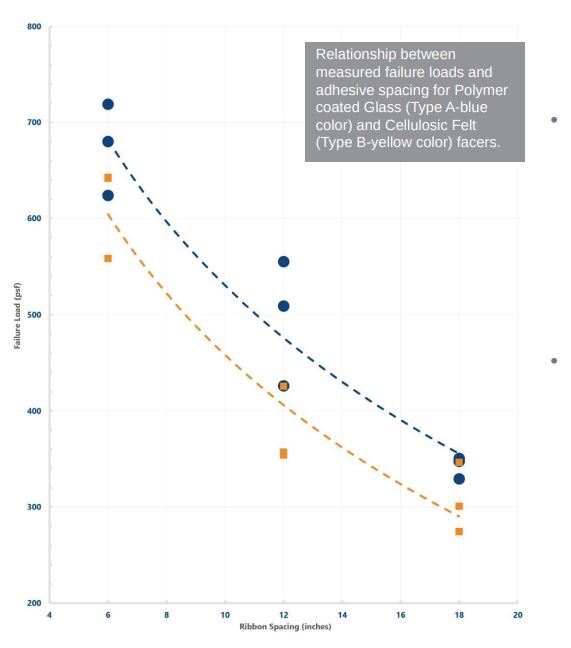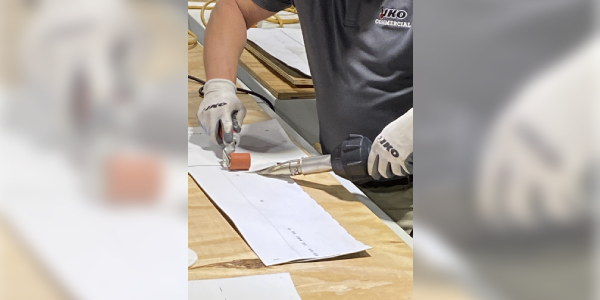Findings of Low Rise Foam Adhesive Test Program

By MRCA.
What impact does variation in foam ribbon spacing have on ultimate roof uplift capacity?
Recently the MRCA Technical and Research Committee commissioned a research and testing program to investigate the effect on bond capacity of various low-rise foam adhesive ribbon spacings used to adhere together layers of polyisocyanurate roofing insulation boards.
To guide the research the MRCA posed a specific question to be answered, “what impact does variation in foam ribbon spacing have on ultimate roof uplift capacity?” The MRCA based this on a very common observation that the “Wand and cartridge installation method by workers is highly variable” and “Not able to produce 'perfect' ribbon spacing by hand.” The program included evaluating both polymer coated fiberglass and cellulosic felt-faced insulation board specimens.
The MRCA engaged Wiss, Janney, Elstner, Associates of Northbrook, Illinois, to conduct research to answer this question, which was completed in October 2019. The research testing utilized a custom designed and fabricated aluminum test fixture secured to a robust steel reaction frame to uniformly apply direct tension loading to full size, 4-foot square adhered insulation specimens. Companion tensile load testing of smaller 12-inch square companion specimens and tests of cured foam material only, with no insulation in the specimen configuration, was also performed.
The MRCA Technical and Research Committee agreed upon a scope of work for the testing. Key details and findings of the test program included:
-
Evaluating the polyisocyanurate insulation adhesive bond strength at agreed upon spacings of 6, 12 and 18 inches.
-
Sourcing tested materials from a single roofing materials manufacturer; which were provided by an MRCA member.
-
Testing eighteen 4-foot square specimens; three each at the six, twelve and eighteen-inch spacings with the two different insulation facer types.
-
Fabricating test specimens by adhering two-inch thick insulation boards to plywood backers that were fabricated with special fasteners that allowed their attachment to the reaction frame while also being removable. After allowing the adhesive between insulation boards and plywood backer to cure, the insulation board facers were then mated and adhered to each other at the pre-determined ribbon spacings.
-
The average measured direct tension strengths for full size polymer coated glass fiber faced specimens were 674, 497 and 342 psf at ribbon spacings of 6, 12 and 18 in., respectively. Average measured direct tension strengths for cellulosic felt faced specimens for ribbon spacings were 614, 379,and 307 psf, for spacings of 6, 12 and 18 inches respectively. The test results were fairly uniform as the computed coefficient of variation was 7 percent and 13 percent for polymer coated glass fiber faced specimens and cellulosic felt faced specimens, respectively.
-
Direct tension strength significantly increased as foam adhesive ribbon spacing decreased, for both the polymer coated glass fiber and cellulosic felt faced insulation specimens. This strong correlation confirms and helps to quantify industry knowledge and practice that higher adhered insulation board uplift resistance is achievable with closer foam adhesive spacings.
-
Polyisocyanurate insulation boards with polymer coated glass fiber facers exhibited approximately 9 to 24 percent higher strengths compared to organic-faced specimens at equal adhesive spacings using the same adhesive type.
-
Failure of the specimens primarily occurred as separations and/or delaminations of the insulation board facer(s) to the foam body core along the lines of the adhesive ribbons, with secondary failures within the body of the insulation noted in some instances, notably at the specimens with closer adhesive ribbon spacings.
-
Testing of 1-foot by 1-foot adhered insulation companion specimens each, with single adhesive ribbon, revealed that polymer coated glass fiber faced specimens were 28 percent stronger than those with cellulosic felt facers, with average strengths of 673 psf and 485 psf, respectively. Testing of companion specimens fabricated with full coverage of adhesive over the entire 1 ft square surface had substantially higher strengths of 833 and 896 psf. These comparative test results confirm that when greater amounts of adhesive is present over a given area, larger portions of the facer/insulation interfacial zone are mobilized to transfer loads between adhered boards.
-
Tensile bond strengths from 1-foot by 1-foot companion tests, in general, were higher and not well correlated with the results for full-size, 4-foot square specimens with 12-inch adhesive spacings. Testing using larger (4-foot square) specimens is considered more representative of real-world installations compared to smaller (1 or 2 foot square) specimens size due to the larger included surface area.
-
The tensile bond strength of the foam adhesive only, without the insulation as an assembly component, was tested using 2-inch diameter aluminum “pucks” attached to threaded rods and pulled apart in a SATEC test machine. Two types of tests were completed in this configuration; testing with a minimal gap between the aluminum pucks, and testing that included a 1/8 inch gap between pucks. The 1/8 inch spacing was achieved by placing the pucks in a custom fabricated jig that controlled the spacing.
-
Testing of the 2-inch diameter pucks with 1/8-inch-thick foam adhesive indicated substantial tensile strength gains between test ages of two days to five days. Average measured strengths were 1,355 psf at two days and 3,361 psf at five days. As expected with two-part polyurethane-based adhesive, chemical cure and associated strength development continues well after initial setting, depending on environment conditions at time of dispensing and thereafter.
-
Testing of adhesive tensile strength utilizing pucks less than 1/16-inch-thick adhesive, although limited in quantity tested, indicated substantial increases in tensile strength compared to those specimens made with 1/8 in. thick adhesive. While this behavior is not necessarily unexpected, it supports the practice of restraining normal foam expansion by appropriate ballasting to minimize adhesive thicknesses (and also producing wider contact zones of the adhesive ribbons) to increase bond strength in real-world installations.
Test program summary
The test data revealed that measured direct tension strength increased as adhesive foam ribbon spacing decreased, for both the polymer coated glass fiber and cellulosic felt faced insulation specimens. Measured strength values at each spacing are plotted in the Figure on page 8 of the full report. There is a proportional relationship between foam adhesive ribbon spacing and uplift strengths are shown as colored dashed lines in the Figure, as represented for each of the nine data points for each facer type.
You can find the full report of the Low Rise Foam Adhesive Research Project at www.mrca.org in the Members Only Section under Exclusive Member Downloads.
Have a technical question or an idea for a research project? Contact Bob Pope, MRCA Executive Director, at 800-497-6722 or bpope@mrca.org.
Learn more about the MRCA in their RoofersCoffeeShop directory.


























Comments
Leave a Reply
Have an account? Login to leave a comment!
Sign In